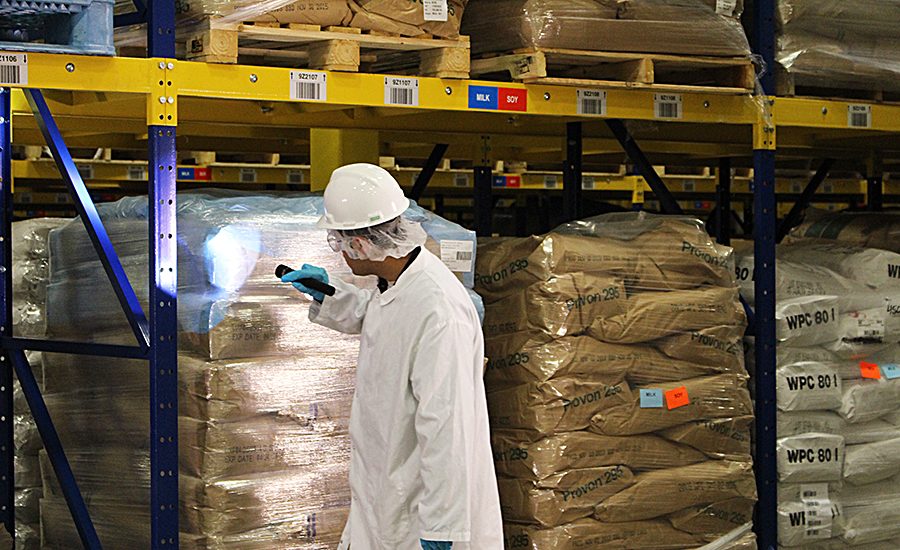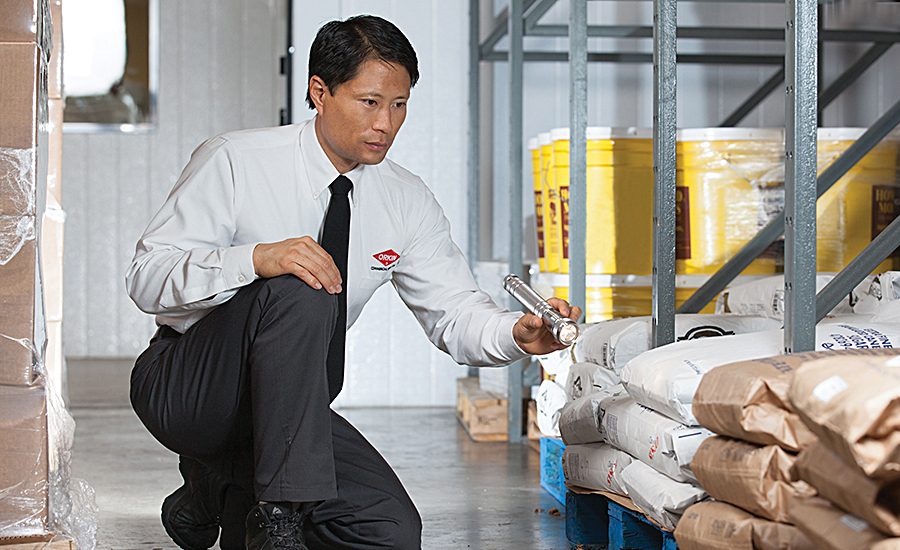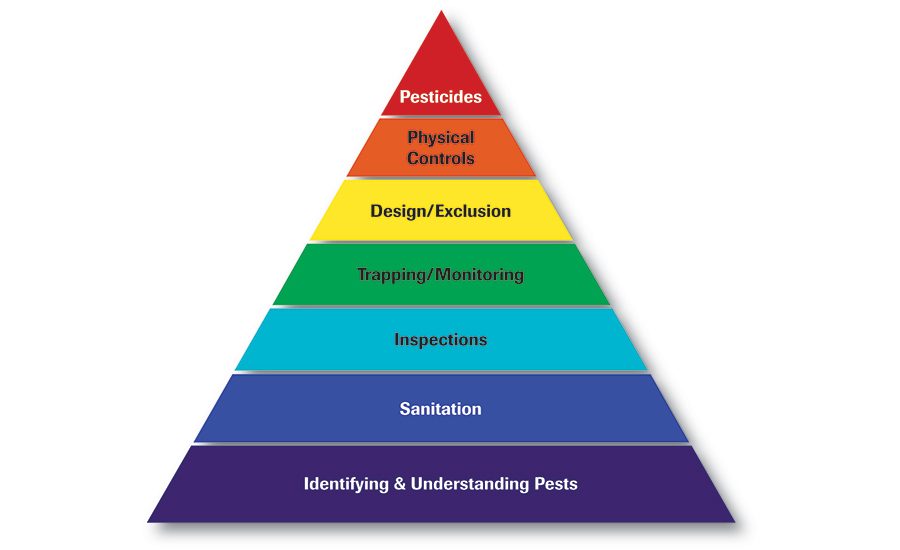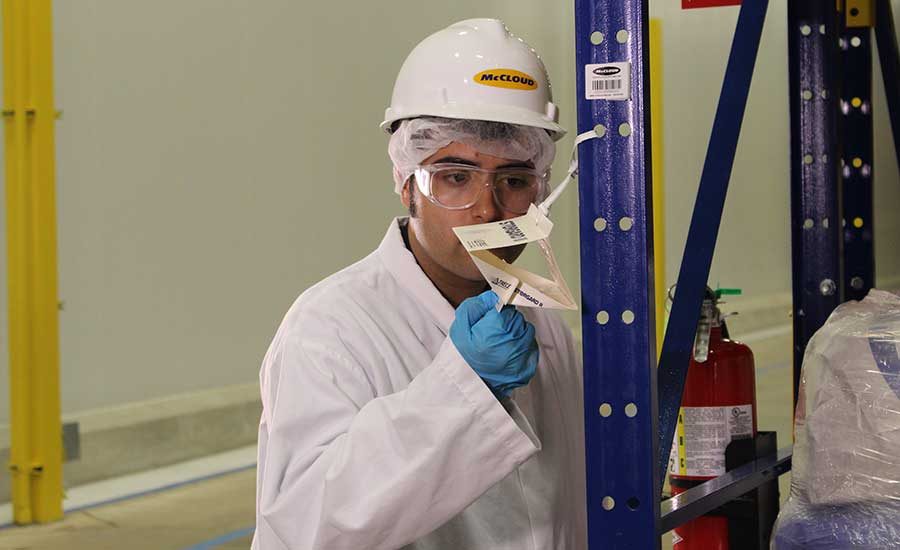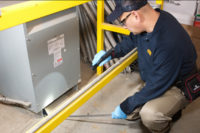When it comes to pests, there is no such thing as a foolproof plan. Pests are sneaky, and their instinct to breed and survive makes food manufacturing and processing facilities prime targets for infestation. Although it’s impossible to keep out every pest, consumer demand for increased transparency and strict food safety requirements from governing bodies make an efficient, effective pest plan vital to a plant’s survival.
Adopting an integrated pest management (IPM) philosophy can help you develop a comprehensive program that addresses sanitation, documentation and pest exclusion and elimination. But, for your plan to be truly integrated, you must commit to an early understanding of your site’s unique risks and involve all your employees in the prevention efforts.
IPM is a comprehensive approach to understanding pests, the risks they pose and how they interact with the environment, combined with a focused effort to exclude and eliminate pests through the use of commonsense practices and treatment methods. According to the Environmental Protection Agency, with IPM, food and beverage facilities can “manage pest damage by the most economical means, and with the least possible hazard to people, property and the environment.”
“Integrated pest management is a process-oriented pest control program that focuses on preventive measures to help reduce the conditions conducive to pest activity,” explains Ron Harrison, Orkin technical services director. “It starts with an assessment, a thorough analysis of the aspects of the facility and the processes that attract pests. Based on that data, a [pest management] provider can design and implement a program to address facility maintenance, sanitation and ongoing monitoring and service to help decrease pest pressure. Lastly, the program should be monitored and adjusted based on pest activity. And, it should be in written form, with any changes or treatments documented.”
An IPM program is nuanced and includes a series of pest management evaluations, decisions and controls that are best implemented with the cooperation of a pest management company. To simplify the implementation, EPA suggests following a four-tiered approach:
- Set action thresholds: Before taking any pest control action, the IPM program should set an action threshold, a point at which pest populations or environmental conditions indicate pest control action must be taken. Determining the level at which pests become an economic threat is critical to guide future pest control decisions.
- Monitor and identify pests: The IPM program should continuously monitor for and identify pests, so appropriate control decisions can be made. Monitoring and identification remove the possibility pesticides will be used when not needed or the wrong kind of pesticide will be used.
- Prevention: An effective IPM program manages the interior and exterior of a plant to prevent pests from becoming a threat. Prevention might include reducing clutter, sealing areas where pests can enter the building, keeping the premises free of trash and overgrown vegetation, and diverting water away from a building or field.
- Control: If prevention methods prove ineffective, the IPM program should evaluate the proper control method. Effective, less risky pest controls, including highly targeted chemicals (e.g., pheromones to disrupt pest mating) or mechanical controls (e.g., trapping or weeding), are preferred. However, if further monitoring, identification and action thresholds indicate these controls are not working, additional pest control methods, such as the targeted deployment of pesticides, should be employed.
For Jerry Heath, product manager at Industrial Fumigant Company, the go-to method for understanding IPM is the pest pyramid, a virtually universal tool companies can use to build their control plans from the ground up. In the base of the pyramid are identifying and understanding pests. Above this level are the tiers for sanitation, inspections, trapping/monitoring, design/exclusion, physical controls and pesticides. Each level of the pyramid, with the exception of the bottom, is built based on information gathered from the previous level.
“The pyramid is very solid and works for virtually all pests and circumstances,” Heath says. “But, if pests are already an issue, you may have to jump to the top of it.”
Attack from the outside in
A variety of pests can cause nightmares for food facilities. These include, but are not limited to, ants, cockroaches, rodents, flies and stored product pests such as beetles and moths. Let’s face it, much of what occurs at a food plant attracts pests.
According to Dominique Sauvage, Copesan director of field operations and quality, pests need four things to survive: food, water, a breeding area and warmth—everything a food processing environment has to offer. So, if you want to make sure your facility isn’t playing host to unwanted guests, you’ll need to control the major means of entry for pests.
Vigilance is necessary, both inside and out. This includes maintaining your facility to prevent entry, as well as proper sanitation of the grounds and removing places where pests can harbor.
Sauvage offers a hypothetical. A bakery is bordered by woods on one side, a river on another and a trucking company and a paper manufacturer on the two remaining sides. According to Sauvage, the biggest threat in this scenario is the river that offers pests the best environment for breeding. Consequently, the food facility should have its supplier doors and other openings on the sides of the facility that do not face the river.
Outside any food facility, garbage containers and dumpsters should be kept clean and covered, and vegetation should be trimmed to eliminate debris around the building. Old equipment left outside should be removed since it could potentially harbor rodents. In addition, drains should be cleared, and drainage should be installed in areas that could become breeding grounds.
Patricia Hottel, technical director at McCloud Services, notes eliminating pest attraction should be a focus for the exterior of the building. For instance, lights that attract flying pests should be avoided; instead, opt for sodium vapor lighting and LEDs if you need to install lighting directly on the structure. Flowering plants or trees that smell as good to pests as they do to humans should also be eliminated where possible, and gravel is always preferable to mulch because of the barrier it creates between the facility and potential pests.
The easiest way for pests to enter your building is through the doors. Lock them down, so pests won’t have the chance to enter and cause problems in the facility. Where possible, install self-closing doors and door sweeps. And, use air curtains or screens on loading docks, if these doors must be kept open.
“You probably have door strips on dock doors to deter flying pests and sweeps to help prevent crawling pests, but think about other ‘doorways’ that allow pests to enter your facility,” Harrison says. “Rodents can squeeze in through holes as small as a dime and cockroaches through a gap that’s just 1/16 of an inch. Look at your facility through pest eyes, and use caulking, sealing, screening and other exclusion methods to eliminate the pest welcome mats.”
Inside your plant, eliminate clutter, and keep the floors clean and free of product residue. Correct any source of moisture such as leaky plumbing or condensation. And, address hard-to-reach and difficult-to-clean areas since these are where filth is likely to build up.
Always inspect incoming supplies, and store ingredients away from windows and walls and off the floor. Remove empty used food containers as soon as possible, and store them away from other products. In addition, storage areas should be monitored regularly for possible infestations, and sticky boards and pheromone traps should be used as needed.
Regular service to your equipment is also imperative to eliminate the buildup of food on machines and moisture and debris underneath them. Any new equipment or line should be evaluated before installation to ensure it can be properly cleaned. And, don’t forget common areas such as locker rooms and cafeterias. They’re the most likely spots for employees to transport pests into the facility, so they must be included in the pest management plan.
Working with professionals
From doorways to landscaping, lighting and facility construction, what these pest management tips illustrate is the need for companies to work with their pest management partners from the beginning—and on a continuous basis.
“We like to be involved in new construction,” notes Elizabeth Johnson, director of marketing for Copesan. “Companies don’t really think about what they are inviting in with an ornamental bush or the proximity of a tree or landscaping. If we’re involved early on, we can help a client prevent the potential problem.”
Getting the pest management partner involved during the design phase is beneficial in dealing with other factors that may be overlooked. For instance, running a cable along a wall to reach an outlet can create a breeding ground for pests and/or harbor debris that can become a feeding station. A pest professional can explain how to optimize outlet locations.
A pest management company also can help with your HVAC; its personnel know proper design is crucial to ensuring a blast of air pushes away flying pests each time a door is opened. According to Judy Black, Rentokil vice president technical services, this consideration is often overlooked during additions or remodels, resulting in negative airflow.
If Sauvage could offer one tip to food facilities, it’s out-of-the-way cleaning—cleaning where you can’t see. “A lot of pest problems can be reduced or solved by exclusion and cleaning,” Sauvage says. “If we can find out why pests are there or what they are eating and drinking, we can handle the problem without pesticide.”
Areas most likely to attract pests should be scheduled for daily cleaning. Other areas can be scheduled for weekly or monthly cleaning. Also consider annual clean-outs for high-moisture and food debris locations throughout your facility.
In addition to cleaning, good sanitation and exclusion tactics, pests are typically kept at bay through the use of pesticides, pheromone traps and bait stations. Traps that feature electronic notification when pests are nearby also can be used.
Harrison says Orkin participates in and monitors research on pest biology that may lead to the development of highly targeted pest control products. “There are new technologies including pheromones that disrupt mating cycles for insects, plus products that sterilize rodents,” Harrison explains. “These types of treatments allow us to address specific pests through biology in a way that minimizes product exposure to chemical treatment.”
Pest management and FSMA
This year, as FDA finalizes the remaining rules of the Food Safety Modernization Act (FSMA), food and beverage manufacturers may be wondering what implications or changes the act will have on pest management. According to Heath, for most facilities already in compliance with audit standards such as GFSI, the new rules won’t be too much of a change since these standards are more rigorous than FSMA legal minimums.
“The stakes might be higher in terms of regulatory action,” Hottel says. “But a well-designed program from two years ago will be in compliance with FSMA.”
Black says before FSMA, preventative controls for pest management included “processing areas.” This language has been broadened, and pest management plans may need to be expanded to include transport vehicles, loading docks and non-food storage areas. Black states similar language changes under FSMA have also lowered the bar for food to be held by inspectors under administrative detention. Prior to FSMA, FDA required “credible evidence” a food product presented a health consequence for it to be held in administrative detention. But FSMA modified this language. Now, Black says there only needs to be “reasonable belief that a food is adulterated or misbranded” for it to be held.
In the eyes of inspectors, pests are a serious problem whose presence needs to be addressed swiftly and backed up by a comprehensive pest program. Loosening this requirement gives inspectors the freedom to hold food if conditions are conductive to pest activity. According to Black, this includes any sightings, droppings, feather marks or cast skins.
A similar phrasing change, “reasonable probability,” appears again in FSMA under the topic of suspending registration. This language reduces the burden of proof FDA would have otherwise needed before it could take action and suspend a facility’s license, leading to costly downtime. “Pest management is always a preventative control, but it may not be considered a risk-based preventative control in every facility,” Black says. “Despite that, because any reasonable belief for adulteration could prompt a records inspection, documenting your pest management actions is important.”
“With FSMA, pest management has always been a prerequisite program. No matter what you are doing or what preventive controls you have in place, you must start by being pest free,” Black says.
Under FSMA, facilities must have a written food safety plan, documentation of corrective actions and verification of the program’s effectiveness through regular service. However, FSMA constitutes a shift from response to prevention as conceptualized in the change from Hazard Analysis Critical Control Point (HACCP) protocols to Hazard Analysis and Risk-Based Preventative Controls (HARPC).
“Responsive pest control means waiting until a pest problem becomes apparent to address it,” Harrison explains. “With prevention, you’re looking for and addressing the root cause of pest activity on an ongoing basis. You catch issues in the earliest— and easiest to remediate—stages rather than facing a crippling infestation. Risk assessment and hazard analysis require a proactive approach to pest management. You must assess and understand what critical points and processes in your facility are at risk for pest activity. By knowing and addressing those vulnerabilities, you reduce the risk of pest activity that poses a threat to food safety.”
According to Heath, a vast majority of food facilities already have some type of pest management program. What is causing some companies anxiety is the new way they will have to disclose their records. “They have always had the records but were not compelled to turn them over,” Heath says. “Now, they might have to go back and put things into a format to accommodate what FSMA requires.”
Sauvage and Heath agree plants could benefit from deeper analyses of their data and monitoring. “Figure out the risk pests pose to your product, how they multiply and understand how they operate,” Sauvage suggests. “Consider what you found, what you did, why you did it and what the next step is.”
Overall success in the age of FSMA depends upon cooperation between a food facility and its pest management company. “Some companies think the pest management comes in and does its work; they don’t need to be involved in pest management,” Black says. “FSMA puts the responsibility [for pest management] on our clients to ensure they partner with a pest management company.”
Integration requires cooperation
Communication between pest professionals and plant managers is critical, and it’s important for plant managers to understand what recommendations are being made and why, especially if additional resources will need to be invested.
During a recent plant assessment, Black says she found a German cockroach problem in an unusually shaped ceiling. “Because of that environment, the solution was to replace the ceiling,” she recalls. A discussion with the plant manager helped Black communicate the need for a costly solution that might have otherwise been dismissed.
“Food facility managers need to talk to their pest control provider, understand their responsibilities and communicate,” Sauvage says. “They should ask for explanations and take the time to know why something needs to be done a certain way today, not tomorrow.”
The food industry is shifting toward transparency, and more companies now use photography to document pest activity and hot spots around their facilities and share the photos with pest professionals when necessary. “We understand the sensitivities and guarded processes, but we encourage photos when we can,” Hottel says.
When it comes to your facility’s IPM program, the more people on board, the better it is. “I love to say getting everyone on board is the solution to solving pest problems,” Black says. “Make sure the employees don’t just understand the importance of reporting the signs, but understand how they play a role in pest prevention.”
Your facility’s pest management partner can help with classes and brief sessions on the pest management program and how to implement new reporting techniques like employee sighting logs.
“Your employees are the frontline of your pest control program,” Harrison states. “They are the eyes and ears that can monitor your facility on an ongoing basis. Make sure your employees are aware of the pest control program and how they can help—from adhering to sanitation and maintenance practices to reporting protocols for pest sightings.”
Heath believes the increased interest in employee training is being driven by audit standards. During this training, employees are educated on key pests, how they operate and why each trap and exclusion device is located where it is.
“The difference between companies with excellent pest management and those that are kind of mediocre is how they involve their employees, including their maintenance department,” Heath says. “A maintenance worker with a few hours and a couple tools can do more good in a short amount of time than more labor-intensive or costly plans.”
For more information:
Judy Black, Rentokil Steritech, 800-868-0089,
judy.black@rentokil.com, www.rentokil.com
Ron Harrison, Orkin, rharrison@orkin.com,
877-846-5089, www.orkincommercial.com
Jerry Heath, Industrial Fumigant Company, 913-397-1183,
jheath@indfumco.com, www.indfumco.com
Patricia Hottel, McCloud Services, 800-332-7805,
pathottel@mccloudservices.com, www.mccloudservices.com
Dominique Sauvage, Copesan, 800-267-3726, ext. 2267,
dsauvage@copesan.com, www.copesan.com
